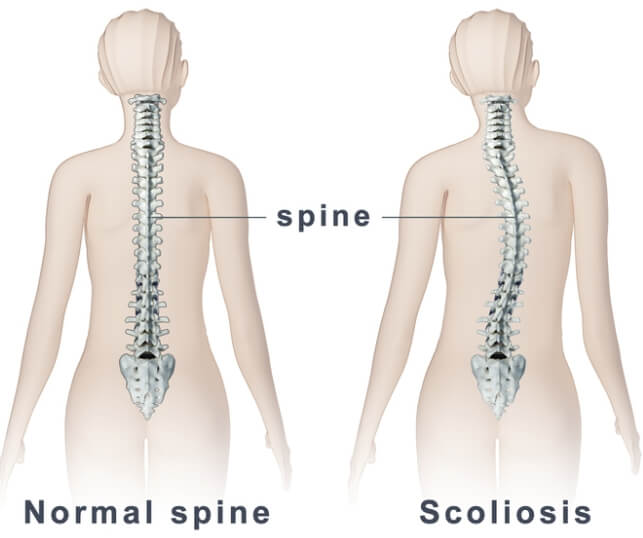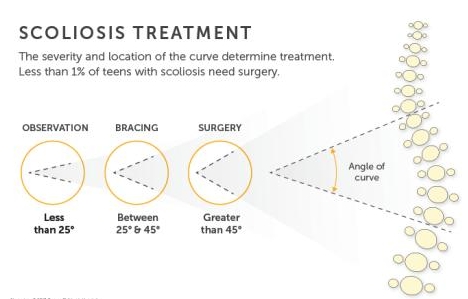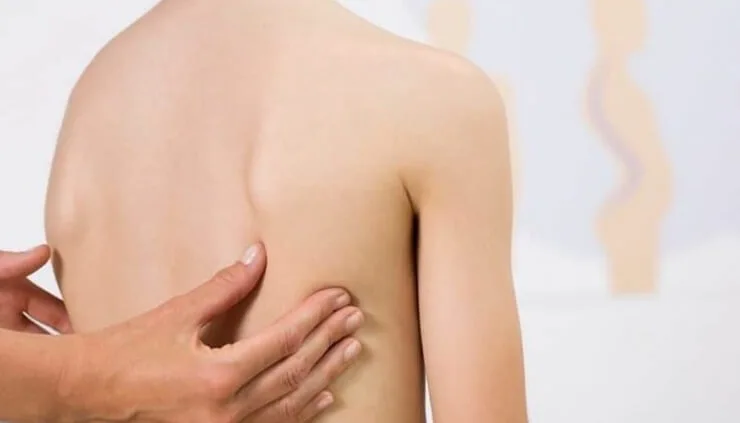Idiopathic scoliosis is a common and far-reaching spinal health problem that occurs primarily in adolescence and adulthood. Idiopathic scoliosis is a condition in which the spine forms a non-normal curve at the side without a clear congenital or structural cause. The problem may first become apparent during growth and development, or it may develop in adulthood. Idiopathic scoliosis treatment is not just about improving appearance, but also about preventing further worsening of symptoms as well as maintaining overall spinal and physical function.
Idiopathic Scoliosis Diagnosis and Assessment
Idiopathic Scoliosis Diagnosis relies on the clinical judgment of a medical professional and advanced imaging techniques. x-ray and digital imaging are two commonly used methods to assess the curvature of the spine and determine the degree of scoliosis. These tools not only provide detailed images of the spine, but also assist physicians in identifying the health of the patient’s spine and provide critical information for treatment planning.
Specialized physicians determine the presence of idiopathic scoliosis by measuring the degree and direction of curvature of the spine. This usually involves a detailed physical examination that includes looking at the patient’s standing posture, shoulder and pelvic symmetry, and checking for other possible spinal abnormalities.
Once idiopathic scoliosis has been diagnosed, the evaluation process proceeds further to determine the type and severity of the curvature. This may include quantifying the angle of the curvature, determining the presence of spiral torsion, and evaluating any other pathologic changes associated with the scoliosis.
A comprehensive evaluation also takes into account factors such as the patient’s overall health, age and lifestyle. This helps to develop a personalized treatment plan to ensure that the treatment options are relevant and effective.

Idiopathic Scoliosis Treatment and Surgical Options
Conservative Idiopathic Scoliosis Treatment:
For mild to moderate idiopathic scoliosis, conservative treatment is a common initial option. This includes physical therapy, specific exercise programs, and the use of spinal braces. Physical therapy can provide support by strengthening the muscles around the spine, improving posture and spinal stability. Meanwhile, spinal supports (braces) are a non-invasive treatment that can help slow the progression of scoliosis.
Surgical Options of Idiopathic Scoliosis Treatment:
In some cases, idiopathic scoliosis may require surgical intervention, especially if the curvature is more severe or if conservative treatments do not meet the patient’s needs.AIS (Adolescent Idiopathic Scoliosis) spine surgery is a common option, which seeks to correct the curvature of the spine through fusion of the vertebrae or implantation of screws and braces. Surgical treatment is usually performed by a specialized spine surgeon who develops the most appropriate surgical plan based on the individual’s condition and degree of curvature.
Individualized Idiopathic Scoliosis Treatment Plan:
It is important that the approach to treating idiopathic scoliosis be individualized. Each patient’s condition and needs are unique, so a team of healthcare professionals needs to carefully evaluate and develop a treatment plan that is best for the patient. This may include a combination of different treatments to maximize the patient’s overall health and quality of life.

Bracing and Surgery
In idiopathic scoliosis treatment, bracing and surgical treatments are designed to correct the curvature of the spine, provide support, and ensure the patient’s overall spinal health.
The Role Of Idiopathic Juvenile Scoliosis Brace:
A brace is a non-invasive treatment tool that can be used to slow the progression of scoliosis. Idiopathic juvenile scoliosis brace is designed to correct the curve of the spine and gradually return the spine to its normal physiologic curvature. Braces are usually custom-fabricated by a specialized spinal orthopedist based on the patient’s type and degree of curvature to ensure optimal results and comfort. The use of braces helps adolescent patients maintain the normal shape of the spine during growth and development, providing a strong foundation for future health.
AIS Spine Surgery:
The curvature of idiopathic scoliosis may reach a point where more direct intervention is needed, at which point surgical treatment becomes one of the options to consider.AIS spine surgery is a widely used approach that involves fusion of the vertebrae and implantation of screws and braces to correct the curvature of the spine. The goal of the surgery is to stabilize the spine and ensure that it maintains its normal physiological curvature after surgery. This procedure is usually performed by an experienced spine surgeon who develops an individualized surgical plan based on the patient’s specific condition.
Post-operative Scoliosis Rehabilitation and Management:
The rehabilitation phase after surgical treatment is crucial. Patients usually require physical therapy to help strengthen the muscles in the surgical area and improve flexibility and adaptability. In addition, patients need regular follow-up visits and checkups to ensure that the results of the surgery are long-lasting and that any potential problems are addressed in a timely manner.
Rehabilitation and Follow-up Management
Idiopathic Scoliosis Physical Therapy:
The core of rehabilitation is physical therapy, which works through a series of exercises and activities designed to strengthen the muscles in the surgical area and improve the body’s stability and adaptability. Physical therapy also helps to improve the patient’s posture and movement patterns, prompting better adaptation to the new physiologic curvature of the spine. Therapists typically develop an individualized rehabilitation plan based on the patient’s specific situation and time since surgery.
Daily Lifestyle Adjustments:
Patients may need to make some lifestyle adjustments after surgery to ensure the long-term health of the spine. This may include continuing to exercise regularly, avoiding overexertion or injury, maintaining good sitting and standing posture, and following the doctor’s recommendations for regular follow-up visits. These lifestyle modifications help to reinforce the effects of treatment and reduce the risk of scoliosis recurrence.
Regular follow-ups and checkups:
Patients need to return to their doctor for regular follow-up visits and examinations to monitor growth and changes in the spine and to ensure that the results of the surgery are long-lasting. Regular imaging tests, such as X-rays or magnetic resonance imaging (MRI), help the doctor understand the health of the spine and respond promptly to any potential problems.
Patient and family support:
idiopathic scoliosis treatment is a long-term process, and patient and family support is crucial. Understanding the treatment process, actively participating in rehabilitation activities, and communicating in a timely manner about interactions with the healthcare team are all key factors in ensuring successful treatment. The active participation of the patient and family helps to create a support system that works together to address challenges that may arise during the rehabilitation process.
About Forethought
In the field of idiopathic scoliosis treatment, Forethought (Shanghai) Medical Technology Co., Ltd. offers unique and superior treatment solutions with its outstanding expertise and state-of-the-art equipment. With leading-edge digital technology and innovative treatments, Forethought has set the standard for technological innovation in the treatment of idiopathic scoliosis, and our mission is to not only treat idiopathic scoliosis, but also to advance the field of spinal health through innovative technology. We are confident that through our efforts, patients will have access to more precise, efficient, and humanized treatment options that will enable them to regain confidence in their recovery and embrace a healthy future. Whether you are a patient, a healthcare professional, or a reader interested in spine health, Forethought is committed to providing you with the best possible experience.
References
- Scoliosis Research Society. “Adolescent Idiopathic Scoliosis (AIS): Overview and Treatment Options.” Available at: https://www.srs.org/patients/conditions/adolescent-idiopathic-scoliosis.
- American Association of Neurological Surgeons. “Idiopathic Scoliosis: Causes, Diagnosis, and Treatment Options.” Available at: https://www.aans.org/Patients/Neurosurgical-Conditions-and-Treatments/Scoliosis.
- National Institute of Arthritis and Musculoskeletal and Skin Diseases. “Scoliosis in Children and Teens.” Available at: https://www.niams.nih.gov/health-topics/scoliosis.
- Children’s Hospital of Philadelphia. “Understanding Bracing for Idiopathic Scoliosis.” Available at: https://www.chop.edu/conditions-diseases/idiopathic-scoliosis.
- Mayo Clinic. “Scoliosis: Diagnosis and Treatment Options.” Available at: https://www.mayoclinic.org/diseases-conditions/scoliosis/diagnosis-treatment/drc-20350792.
- The Spine Journal. “Efficacy of Bracing and Surgical Treatment in Idiopathic Scoliosis.” Available at: https://www.spinejournal.com/article/S1529-9430(19)30177-2/fulltext.
- National Scoliosis Foundation. “Postoperative Rehabilitation and Long-Term Management for Scoliosis Patients.” Available at: https://www.scoliosis.org/resources/post-operative-care.
- OrthoInfo – American Academy of Orthopaedic Surgeons. “Bracing for Adolescent Idiopathic Scoliosis.” Available at: https://orthoinfo.aaos.org/en/diseases–conditions/adolescent-idiopathic-scoliosis.
- The Journal of Bone & Joint Surgery. “Surgical Outcomes for Adolescent Idiopathic Scoliosis: Long-Term Analysis.” Available at: https://journals.lww.com/jbjsjournal/fulltext/2020/01010/surgical-outcomes-for-adolescent-idiopathic.10.aspx.
- The British Scoliosis Society. “Guidelines for the Management of Adolescent Idiopathic Scoliosis.” Available at: https://www.britscoliosis.org/guidelines.
- Global Spine Journal. “Advances in Non-Surgical and Surgical Treatment of Idiopathic Scoliosis.” Available at: https://journals.sagepub.com/doi/full/10.1177/2192568220926762.
- International Journal of Spine Surgery. “Comparative Analysis of Bracing and Surgery in Idiopathic Scoliosis.” Available at: https://www.ijssurgery.com/content/15/1/23.
- Scoliosis and Spinal Disorders Journal. “Long-Term Follow-Up in Adolescent Idiopathic Scoliosis After Surgical Intervention.” Available at: https://scoliosisjournal.biomedcentral.com/articles/10.1186/s13013-020-0151-8.
- Clinical Spine Surgery. “Postoperative Rehabilitation and Patient-Centered Care in Scoliosis Treatment.” Available at: https://journals.lww.com/spinejournal/Abstract/2021/02000/Postoperative_Rehabilitation_in_Scoliosis.14.aspx.
- Forethought Medical Technology Co., Ltd. “Innovative Technologies in Scoliosis Diagnosis and Treatment.” Available at: https://www.forethoughtmedical.com/idiopathic-scoliosis.

